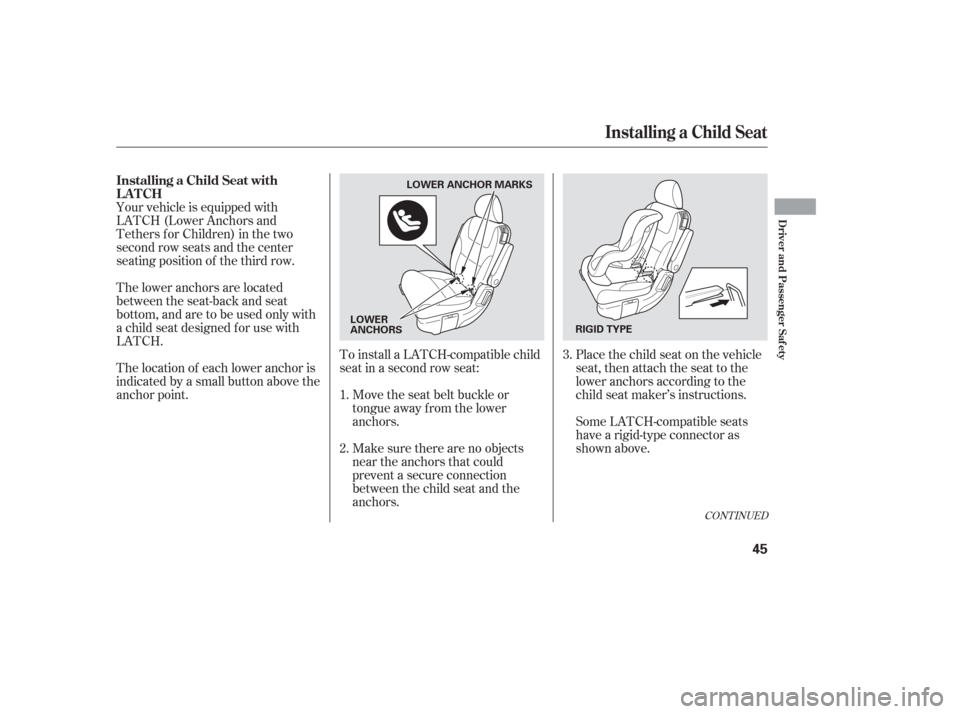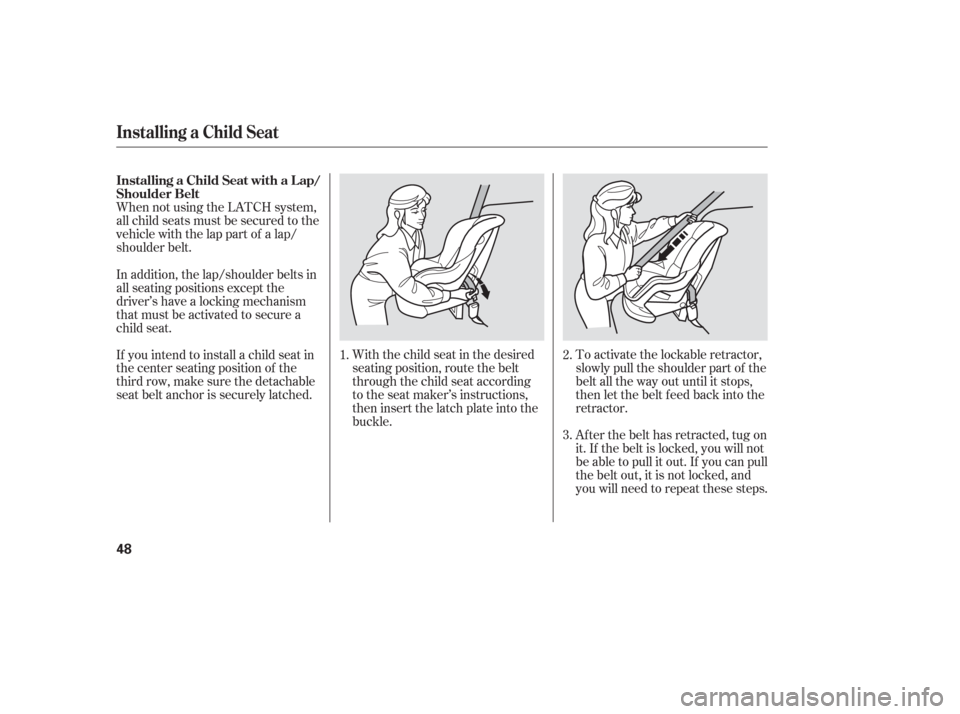Page 46 of 420

Place the child seat on the vehicle
seat, then attach the seat to the
lower anchors according to the
child seat maker’s instructions.
Your vehicle is equipped with
LATCH (Lower Anchors and
Tethers f or Children) in the two
second row seats and the center
seating position of the third row.
The lower anchors are located
between the seat-back and seat
bottom, and are to be used only with
a child seat designed f or use with
LATCH.
The location of each lower anchor is
indicated by a small button above the
anchor point.
Some LATCH-compatible seats
have a rigid-type connector as
shown above.
To install a LATCH-compatible child
seat in a second row seat:
Make sure there are no objects
near the anchors that could
prevent a secure connection
between the child seat and the
anchors. Move the seat belt buckle or
tongue away f rom the lower
anchors.
1.
2. 3.
CONT INUED
Installing a Child Seat
Installing a Child Seat with
LATCH
Driver and Passenger Saf ety
45
RIGID TYPE
LOWERANCHORMARKS
LOWER
ANCHORS
Page 47 of 420
Whatever type you have, f ollow
the child seat maker’s instructions
f or adjusting or tightening the f it.
Other LATCH-compatible seats have
a f lexible-type connector as shown
above. Attach the tether strap hook to the
tether anchor, then tighten the
strap as instructed by the child
seat maker.
Push and pull the child seat
f orward and f rom side-to-side to
verify that it is secure.
Lif t the head restraint (see page ), then route the tether strap
through the legs of the head
restraint, over the seat-back and
through the grab rail, making sure
the strap is not twisted.
4. 5.6.
7.
157
Installing a Child Seat
46
FLEXIBLE TYPE ANCHOR
Page 48 of 420
Slide the anchor cover to open it,
then follow steps 6 and 7 of the
second row installation (see page).
Followsteps1through4of the
second row installation (see pages
and ).
To install a LATCH-compatible child
seat in the center seating position of
the third row:
Unlatch the detachable seat belt
anchor latch and retract the seat
belt all the way into the ceiling.
Place the latch plate and anchor
latch in their holding slots (see
page ).
Remove and safely store the head
restraint, then route the tether
strap over the seat-back, making
sure the strap is not twisted.
1.
2.3.
4.
46
45 46
18
Installing a Child Seat
Driver and Passenger Saf ety
47
Page 49 of 420

When not using the LATCH system,
all child seats must be secured to the
vehicle with the lap part of a lap/
shoulder belt.With the child seat in the desired
seating position, route the belt
through the child seat according
to the seat maker’s instructions,
then insert the latch plate into the
buckle.To activate the lockable retractor,
slowly pull the shoulder part of the
belt all the way out until it stops,
then let the belt f eed back into the
retractor.
Af ter the belt has retracted, tug on
it. If the belt is locked, you will not
be able to pull it out. If you can pull
thebeltout,itisnotlocked,and
you will need to repeat these steps.
In addition, the lap/shoulder belts in
all seating positions except the
driver’s have a locking mechanism
that must be activated to secure a
child seat.
If you intend to install a child seat in
the center seating position of the
thirdrow,makesurethedetachable
seat belt anchor is securely latched.
1.
2.
3.
Installing a Child Seat
Installing a Child Seat with a L ap/
Shoulder Belt
48
Page 50 of 420
To remove slack, it may help to put
weight on the child seat, or push on
the back of the seat while pulling up
on the belt.Push and pull the child seat
f orward and f rom side-to-side to
verif y that it is f irmly secured. If
the child seat is not secure,
unlatch the belt, allow it to retract
f ully, then repeat these steps.
To deactivate the locking
mechanism and remove a child seat,
unlatch the buckle, unroute the seat
belt, and let the belt f ully retract.
Af ter conf irming that the belt is
locked, grab the shoulder part of
the belt near the buckle, and pull
up to remove any slack from the
lap part of the belt. Remember, if
the lap part of the belt is not tight,
the child seat will not be secure.
5.
4.
Installing a Child Seat
Driver and Passenger Saf ety
49
Page 51 of 420
Each second row bucket seat has a
tether anchorage point at the bottom
of the seat-back.Af ter properly securing the child
seat (see page ), lif t the head
restraint, then route the tether
strap over the seat-back and
through the head restraint legs.
A child seat with a tether can be
installed in any seating position in
the second or third row seats.
Since a tether can provide additional
security, we recommend using a
tether whenever one is required or
available.
1.48
Installing a Child Seat
Installing a Child Seat with a
TetherSecond Row Inst allat ion
50
TETHER ANCHORAGE POINT
Page 52 of 420
Attach the tether strap hook to the
anchor, making sure the strap is
not twisted.
Tighten the strap according to the
seat maker’s instructions.Remove the head restraint and
safely store, then route the tether
strap over the seat-back.
Slide the anchor cover to open it.
Follow step 2 and 3 of the second
row installation.
The center seating position of the
third row has an anchorage point on
the tailgate sill.
Each outside seating position of the
third row has an anchorage point on
the seat-back.
To install a child seat in either
outside seating position, open the
anchor cover, then f ollow steps 1
through 3 of the second row
installation.
2.
1.
3.
2.
3.
T hird Row Inst allat ion
Installing a Child Seat
Driver and Passenger Saf ety
51
ANCHORAGE POINTS
Center Position
Outside Position
Page 53 of 420
To determine if a lap/shoulder belt
properly f its a child, have the child
put on the seat belt, then ask
yourself :Does the child sit all the way back
against the seat?
Do the child’s knees bend
comf ortably over the edge of the
seat?
When a child reaches the
recommended weight or height limit
for a forward-facing child seat, the
child should sit in a back seat on a
booster seat and wear a lap/shoulder
belt.
The f ollowing pages give
instructions on how to check proper
seat belt f it, what kind of booster
seat to use if one is needed, and
important precautions f or a child
who must sit in f ront.
1.
2.
Protecting L arger Children
Checking Seat Belt Fit
52
Allowing a child age 12 or under
to sit in front can result in injury
or death if the passenger’s front
airbag inflates.
If a child must ride in front,
move the vehicle seat as far
back as possible, use a booster
seat if needed, have the child
sit up properly and wear the
seat belt properly.